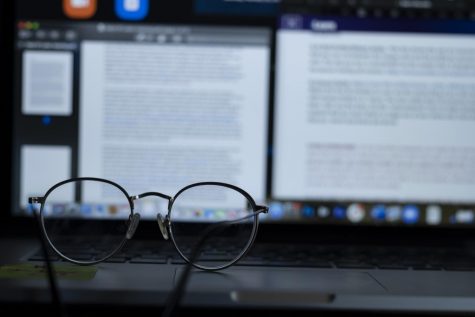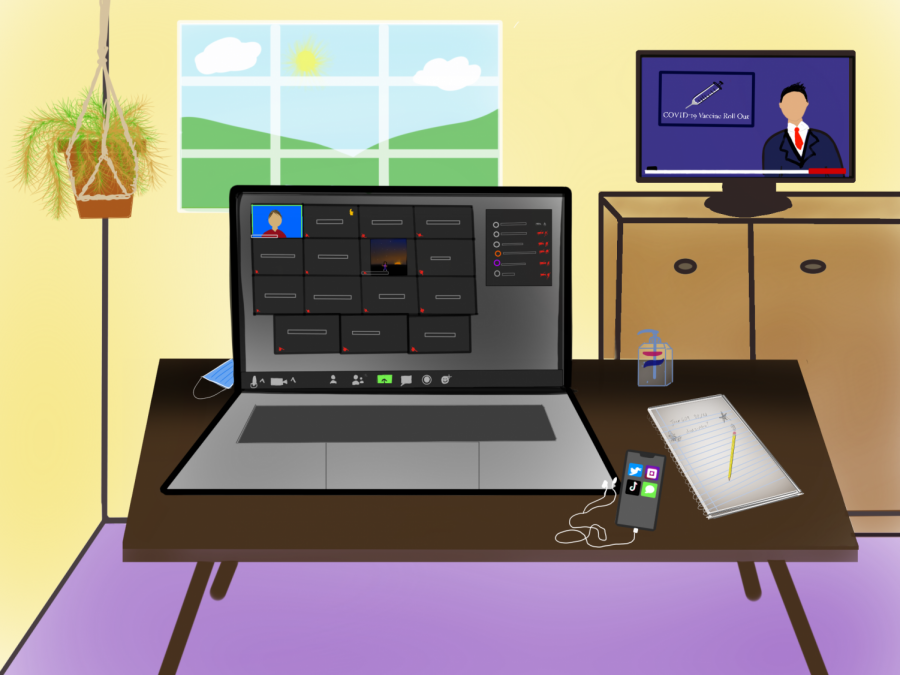As our education transitioned to a virtual learning format, teachers at every grade level had to adapt and learn new methods to educate their students; dealing with many roadblocks and problematic issues they were not accustomed to.
Teachers – like Jill Hendricks who teaches music at George Washington High School – have been forced to adjust throughout the pandemic while experiencing technical issues, lack of participation and lack of virtual engagement.
“I’m not a big tech person, so it took me a while to just figure out how to do everything,” Hendricks said. “I think for me and my students both, the biggest thing for us in general is the lack of social interaction because that’s how we get to know each other. That’s how we create beautiful music together and now we’re stuck behind the screen.”
It has been almost a year since students were sent home from their schools to switch to remote learning due to the coronavirus outbreak. Classes have converted to a virtual format where instructors are now staring at their students through boxes on a computer screen.
According to director of University Teaching Virginia Pitts, privacy concerns may arise when teachers require their students to have their cameras on for the entirety of the Zoom meetings. Since most students are on mute and many leave their cameras off, this causes the teachers to lack a sense of connection with their class, often making it hard to know if they are even there.
“I think it’s better for all of us to have the cameras on and participate because we are losing our sense of humanity,” said Hendricks. “I’ll get a kid that will just put their answer in the chat and I’m like ‘Seriously, unmute yourself and talk to me like a human being, let’s not lose that!”
Interaction is a crucial part of education. Certain courses such as music, physical education, photography and others may find themselves in more challenging situations than others dealing with the virtual elements. Many instructors may find themselves spending more of their time with their work.
“It started off really awkward more than anything. It was new for everyone, teachers and students,” said Natalie Massarany, health and biology teacher at John O’Connell High School. “Mostly kids just had questions along the lines of, ‘What the heck is going on?’ As well as concerns for their safety given the pandemic and the fear that was spread.”
As teachers were forced to adapt to virtual learning, they faced pressure to quickly get adjusted to the transition.
“It was a lot of pressure on schools and teachers to continue as normal, but to do it online and to teach the content while finding ways to assess students,” said Massarany. “Every day that was mostly just uncomfortable, we were all sort of forced to adapt and I don’t think any teachers felt like that was the best way to approach the situation.”
Students may feel uncomfortable being the first one to turn on their camera while most of their peers have theirs turned off.
“On its worst days I feel like I’m live streaming on YouTube,” Massarany said. “Nobody wants to be the first one to turn on their camera. Which i think is normal in a high school environment, everybody is reading the room. Normally the downs in any school environment like when kids aren’t engaged, there’s a way to rally the team and liven up the room. I don’t find it’s as easy on zoom.”

Horace Mann Educators Corporation conducted research based on a national survey of 1,240 U.S. educators between Oct. and Nov. 2020. Compared to a year ago, 77.1% of educators said they are spending more time on their job.
This same survey reported 60.2% of educators are enjoying their work less than before, and 58.9% do not feel secure working under their school district’s health and safety precautions.
Technical glitches and internet connections continue to frustrate both students and teachers because of how often they encounter problems during their online learning experience.
“I think it was a daily occurrence that there was some sort of a technical difficulty,” said Morgan Malone, kindergarten teacher at Greenbrook Elementary. “We have some kids who live up in the hills where their reception and internet service aren’t as consistent as others.”
“You just try and make the best of it and as a teacher you just really understand that it’s never the student’s fault,” said Malone. “These little kids can’t handle these issues so it’s just a matter of going with the flow and hoping they can get resolved as quickly as possible.”
In an article by the New York Times, Jered Borup, associate professor in learning technologies at George Mason University, stated research found it is generally harder for instructors to keep their students engaged in virtual lessons. As a result, they all may have their own strategies on how to solve this issue.
“For some students it is definitely difficult to engage online. The way we did it is we had a few time slots where we met together as a whole group and then I would either meet them in small groups or individually,” said Malone.
As teachers expressed frustration with remote learning, the California Department of Education provided information to assist local education agencies during school closures and the transition into online learning.
CDE provided a FAQ guide regarding how grading policies for distance learning were to be determined. According to their website, districts can consider modifying their grading system to pass or fail, credit or no-credit, or general letter grades.
Although some students may be content with remote learning, teachers have expressed their frustration with numerous issues including more students failing.
“I feel that grades are not as important to many students now,” said Marcie Dobbs, English language arts teacher at Francisco Middle School. “We were not allowed to give anyone a failing grade really, unless we have contacted home many times, kept our grades up to date, and made a plan for how students will make up work that they have missed.”
“Students who need additional help or support are not very vocal about their needs, it is hard to discern what they really need as a teacher online,” said Dobbs.
It can be a difficult task for educators and tutors such as Jeanivy Cabantac, academic coach at the Sylvan Learning Center, to determine a fair grading system and to deal with the students’ engagement. Specifically, the younger ones who can easily get distracted.
“It’s a challenging experience, the kids have to be monitored because they easily get distracted,” said Cabantac. “We’re trying our best to have them focus on their zoom classes and live discussions because it’s important for them to learn during this pandemic.”
Cabantac added that there can be additional distractions that children find at home which affect their attention.
“It’s really difficult for them to focus and it depends on the age,” Cabantac said. “Sometimes the 13-year-olds will be in their zoom class but at the same time they will be on their phone or iPad and get distracted.”
Younger kids may often find it harder to adjust to the virtual education experience. Fatigue from the interaction with the computer software could possibly make these kids feel drained and less engaged, according to an article written by Virginia Pitts, director of university learning at University of Denver.
Teachers, in response to the students’ struggles, are giving fewer daily assignments and focusing more on important projects. They are also allowing students to redo their work and providing extensions, according to an article by Chalkbeat.
As vaccines continue to be dispersed and COVID-19 cases are declining, teachers, students and parents are both hopeful and eager for schools to return back to their normal environments prior to the pandemic.
“It’s just trying to present the material in the most engaging and fascinating way possible,” said Malone. “ You try to change the method of teaching frequently to keep that engagement going.”







